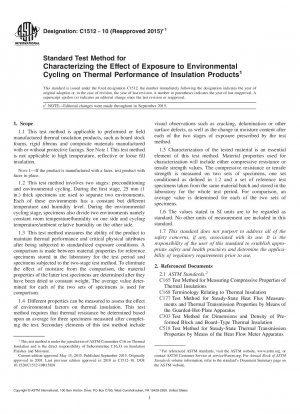ASTM C1512-10(2015)e1
Standard Test Method for Characterizing the Effect of Exposure to Environmental Cycling on Thermal Performance of Insulation Products
- Standard No.
- ASTM C1512-10(2015)e1
- Release Date
- 2010
- Published By
- American Society for Testing and Materials (ASTM)
- Status
- Replace By
- ASTM C1512-10(2020)
- Latest
- ASTM C1512-10(2020)
- Scope
5.1 Exposing a specimen to conditions of one-directional environmental cycling can increase its moisture content until a decrease in material properties occurs (at a specific number of cycles). Such a test could be inappropriate due to the number of cycles required to cause a decrease in material properties since product performance issues often arise only after many years of exposure. The use of a preconditioning procedure is not intended to duplicate expected field performance. Rather the purpose is to increase the moisture content of test materials prior to subjecting to them to environmental cycling.
5.2 The most important aspect of the preconditioning procedure is non-uniform moisture distribution in the specimen. The heat flow is one directional causing moisture flow towards the cold side resulting in zones of dry material on the warm side and high moisture content on the cold side. (Whether the high moisture content zone is located right at the cold surface of the specimen or at some distance from this surface depends upon temperature oscillation and ability of the cold surface to dry outwards). Because the preconditioning procedure involves thermal gradient, this preconditioning procedure results in a distribution of moisture content that may occur under field exposure conditions. However, the resulting moisture content may differ significantly from that which may be demonstrated in typical product applications.
5.3 The preconditioning results in accumulation of moisture in the thermal insulation resulting from the simultaneous exposure to a difference in temperature and water vapor pressure. This test method is not intended to duplicate field exposure. It is intended to provide comparative ratings. As excessive accumulation of moisture in a construction system may adversely affect its performance, the designer should consider the potential for moisture accumulation and the possible effects of this moisture on the system performance.
1.1 This test method is applicable to preformed or field manufactured thermal insulation products, such as board stock foams, rigid fibrous and composite materials manufactured with or without protective facings. See Note 1 This test method is not applicable to high temperature, reflective or loose fill insulation.
Note 1: If the product is manufactured with a facer, test product with facer in place.
1.2 This test method involves two stages: preconditioning and environmental cycling. During the first stage, 25 mm (1 in.) thick specimens are used to separate two environments. Each of these environments has a constant but different temperature and humidity level. During the environmental cycling stage, specimens also divide two environments namely constant room temperature/humidity on one side and cycling temperature/ambient relative humidity on the other side.
1.3 This test method measures the ability of the product to maintain thermal performance and critical physical attributes after being subjected to standardized exposure conditions. A comparison is made between material properties for reference specimens stored in the laboratory for the test period and specimens subjected to the two-st......
ASTM C1512-10(2015)e1 Referenced Document
- ASTM C165 Standard Test Method for Measuring Compressive Properties of Thermal Insulations
- ASTM C168 Standard Terminology Relating to Thermal Insulation
- ASTM C177 Standard Test Method for Steady-State Heat Flux Measurements and Thermal Transmission Properties by Means of the Guarded-Hot-Plate Apparatus
- ASTM C303 Standard Test Method for Dimensions and Density of Preformed Block and Broad-Type Thermal Insulation
- ASTM C518 Standard Test Method for Steady-State Thermal Transmission Properties by Means of the Heat Flow Meter Apparatus
- ASTM C618 Standard Specification for Fly Ash And Raw Or Calcined Natural Pozzolan For Use As A Mineral Admixture In Portland Cement Concrete
- ASTM C870 Standard Practice for Conditioning of Thermal Insulating Materials
- ASTM D1621 Standard Test Method for Compressive Properties of Rigid Cellular Plastics
- ASTM D1623 Standard Test Method for Tensile And Tensile Adhesion Properties Of Rigid Cellular Plastics
- ASTM E177 Standard Practice for Use of the Terms Precision and Bias in ASTM Test Methods
- ASTM E691 Standard Practice for Conducting an Interlaboratory Study to Determine the Precision of a Test Method
ASTM C1512-10(2015)e1 history
- 2020 ASTM C1512-10(2020) Standard Test Method for Characterizing the Effect of Exposure to Environmental Cycling on Thermal Performance of Insulation Products
- 2010 ASTM C1512-10(2015)e1 Standard Test Method for Characterizing the Effect of Exposure to Environmental Cycling on Thermal Performance of Insulation Products
- 2015 ASTM C1512-10(2015) Standard Test Method for Characterizing the Effect of Exposure to Environmental Cycling on Thermal Performance of Insulation Products
- 2010 ASTM C1512-10 Standard Test Method for Characterizing the Effect of Exposure to Environmental Cycling on Thermal Performance of Insulation Products
- 2007 ASTM C1512-07 Standard Test Method for Characterizing the Effect of Exposure to Environmental Cycling on Thermal Performance of Insulation Products
- 2001 ASTM C1512-01 Standard Test Method for Characterizing the Effect of Exposure to Environmental Cycling on Thermal Performance of Insulation Products

Copyright ©2024 All Rights Reserved